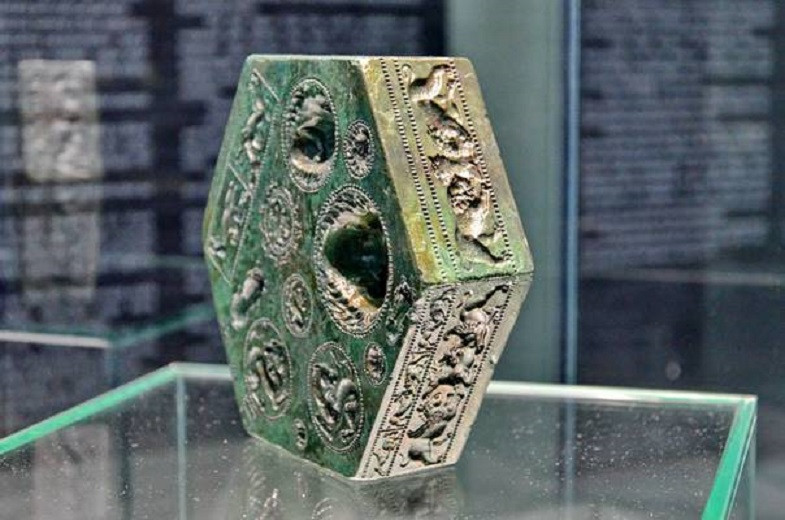In the fascinating world of archaeological discoveries, few artifacts have the power to spark the imagination quite like the hexagonal bronze matrix unearthed at Sarmizegetusa Regia in Romania. Unearthed in 2013 from beneath the roots of a tree toppled by a storm, this extraordinary artifact, estimated to be around 2,000 years old, has become a centerpiece at the Dacian and Roman Civilization Museum in Deva. Its intricate craftsmanship and historical significance make it an unparalleled treasure of the ancient world.

Weighing approximately 8 kilograms and measuring 5 centimeters thick, the hexagonal matrix is an exceptional example of Dacian artistry. Each of its eight facets is adorned with intricate sculptures that bring to life a diverse collection of mythical and real creatures, including griffins, lions, and tigers. These designs provide a captivating glimpse into the symbolism and artistic traditions that influenced the ancient Mediterranean and Pontic cultures, reflecting the interconnectedness of civilizations during this period.
Scholars and historians believe that the bronze matrix was an essential tool for Dacian jewelers. Its detailed carvings suggest it was used to create ornate decorative pieces from precious metals, showcasing the sophistication of Dacian craftsmanship. The matrix’s discovery in Sarmizegetusa Regia, the political and cultural heart of the Dacian Kingdom, underscores the region’s prominence as a hub of artistic and technological innovation during a tumultuous time marked by Roman conquest and cultural exchange.
The craftsmanship of this matrix is truly remarkable, serving as a testament to the unparalleled skill of ancient Dacian artisans. The seamless blending of real and mythical creatures into its designs demonstrates a mastery of metalworking techniques that rivals the finest artisans of the ancient world. Each detail, from the lifelike depiction of animals to the imaginative portrayals of mythical beasts, reveals a level of precision and creativity that continues to inspire admiration and intrigue.
Beyond its artistic significance, the matrix stands as a symbol of the Dacian civilization’s resilience and ingenuity. During a period when the Roman Empire sought to dominate and assimilate surrounding cultures, the Dacians demonstrated a remarkable ability to preserve and celebrate their heritage through artistic expression. This artifact not only highlights their technological advancements but also serves as a reminder of their cultural identity and pride.
Today, the hexagonal matrix holds a place of honor at the Dacian and Roman Civilization Museum in Deva. Recognizing its immense historical value, the museum has taken great care to preserve and showcase the artifact in a secure, dedicated room. Visitors from around the world are invited to marvel at its intricate details and explore the story it tells about a civilization that thrived on the frontier of the Roman Empire.
The matrix’s unique status as the only known artifact of its kind in Europe adds to its allure. It provides a rare glimpse into the tools and techniques used by ancient craftsmen, offering invaluable insights into the technological prowess of the Dacians. Furthermore, it serves as a poignant reminder of the innovative spirit and cultural resilience that defined their civilization.
For archaeologists and history enthusiasts alike, the discovery of this matrix is a source of endless fascination. Its intricate design and historical context offer a wealth of information about the artistic and cultural legacy of the Dacians, illuminating a chapter of history that often remains overshadowed by the narrative of Roman conquest. As researchers continue to study this artifact, new insights are uncovered, deepening our understanding of the complex interplay between ancient civilizations.
The hexagonal bronze matrix is more than just an artifact; it is a bridge to the past. It invites us to reflect on the ingenuity and creativity of our ancestors, who, despite facing immense challenges, found ways to celebrate beauty and innovation through their art. This 2,000-year-old treasure not only enriches our knowledge of the ancient world but also inspires us to appreciate the enduring power of human creativity.
As visitors stand before the matrix in the museum, they are transported back in time, imagining the hands of a skilled Dacian artisan meticulously carving its intricate designs. The artifact’s survival through centuries of history is a testament to its enduring significance and the lasting impact of the culture that created it. It is a powerful reminder of the stories that artifacts can tell and the connections they forge between past and present.
In conclusion, the hexagonal bronze matrix from Sarmizegetusa Regia remains a remarkable symbol of the Dacian civilization’s artistic and cultural achievements. Its discovery has not only captivated archaeologists and historians but also provided a valuable window into a world that existed two millennia ago. As it stands proudly on display, this extraordinary artifact continues to inspire awe and admiration, inviting us to celebrate the ingenuity of ancient artisans and the rich legacy they left behind.





